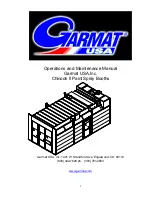
_________________________________________________________________________________________
schunk.com
XND.00019.003_A – 10/2018
31
4.3.3
Setting up the jaw positions
Fixed jaws:
1)
It is important to ensure that the gearing of the base plate
and jaws is clean and free from chips.
2)
The four M10 fixing screws (No. 50) have to be released far
enough so that the locking rollers with the wave springs
(No. 30) are located in the upper indent of the clamping buckle
(No. 40).
3)
When the fixed jaw (No. 20) has already been clamped, release
the screws by approx. 3 turns. This means that the locking
rollers are in open position.
4)
Insert / extend the fixed jaw from above into the base plate
(No. 10).
5)
Tighten the four M10 fixing screws crosswise; the clamping
buckle is pulled upwards, the locking rollers are pushed
outwards and clamped in close contact with the shape
between the clamping buckle and base plate.
6)
Visually check that the locking is correct; the locking rollers
6)
must make full contact on both sides with the round shape of
the base plate, which means that they are exactly half-way
under the base plate. If there is any doubt, the locking should
be released and the process repeated.
7)
Tighten the M10 fixing screws with a torque of 50 Nm.
2) 3)
4)
5)
Important
:
Before clamping the workpiece, the M10 fixing screws (No. 50) have to be
tightened with 50 Nm.
Failure to observe this instruction can lead to inadequate workpiece clamping and
hence to loss of the workpiece and damage.
Note:
the scale helps to position the jaws when the same positions have to be repeated.






































